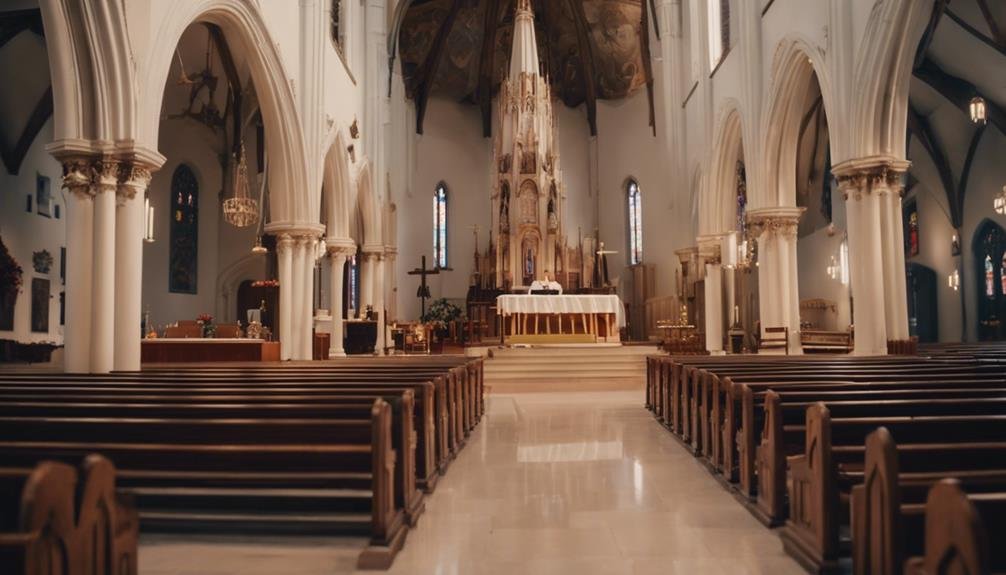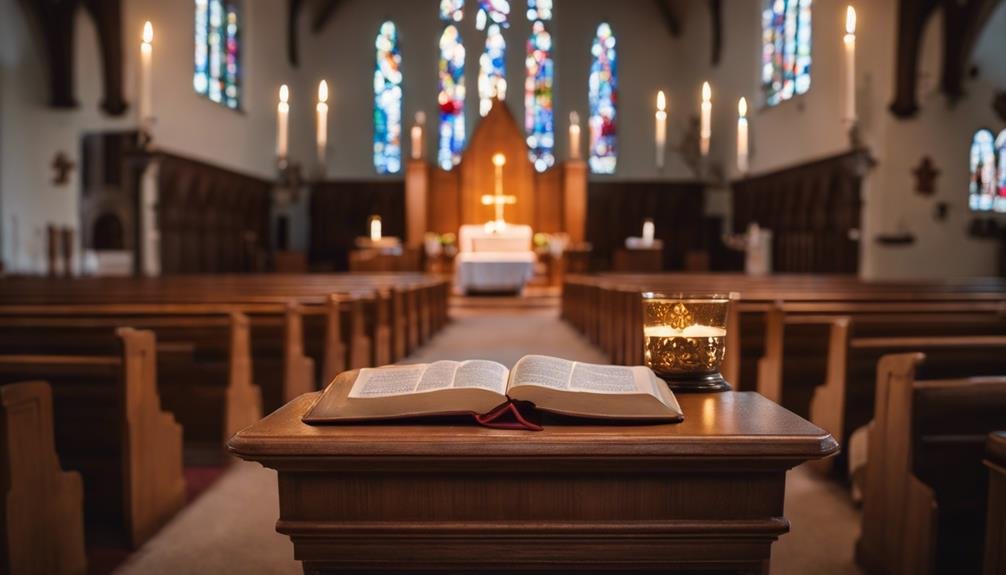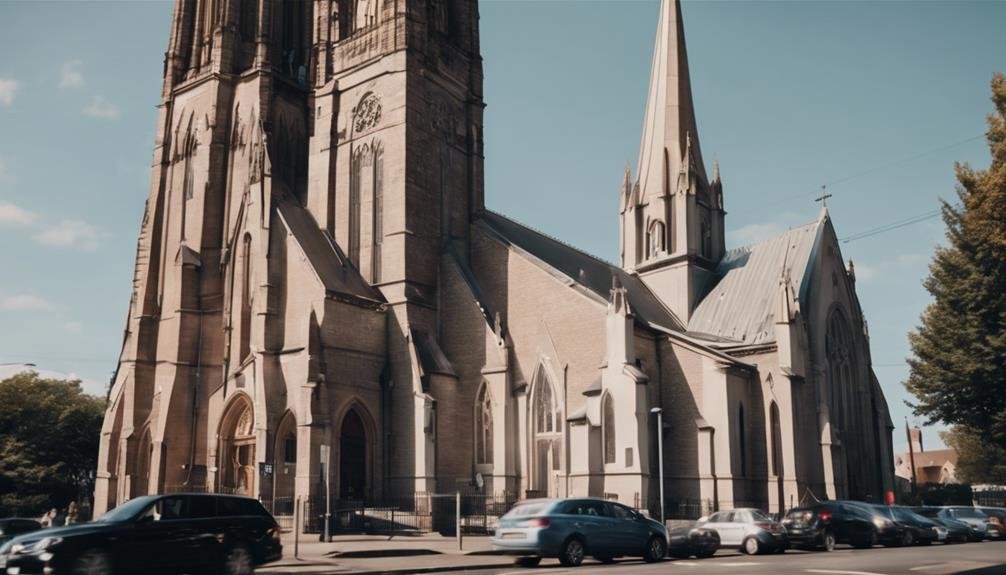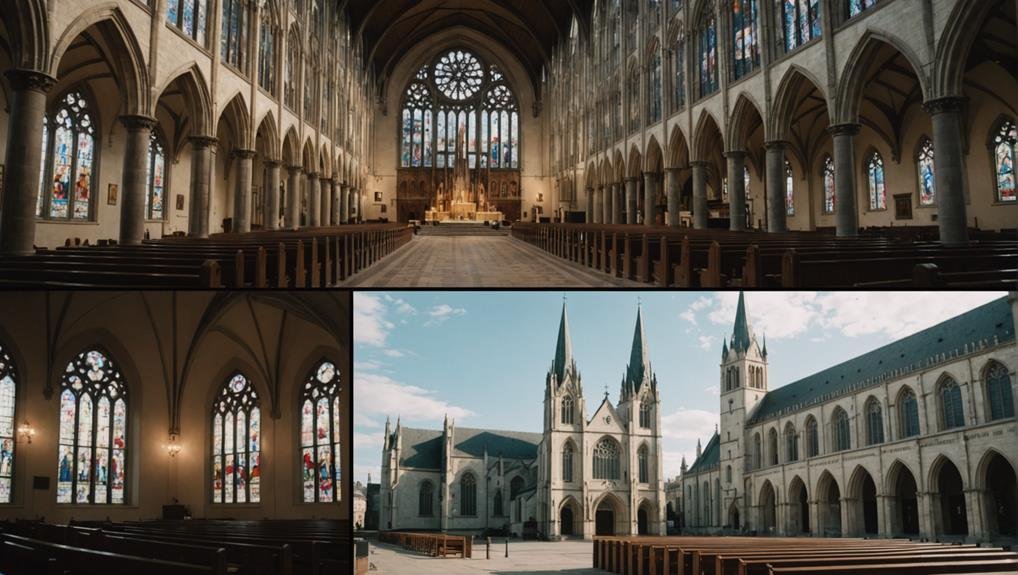When you compare Methodist and Catholic traditions, you’ll find significant differences in their beliefs and practices, particularly concerning salvation, authority, sacraments, and worship. The Catholic Church emphasizes a combination of faith, good works, and sacraments, while Methodists focus on justification by faith alone and God’s grace being accessible to all. These contrasting views shape their leadership structures and worship styles in unique ways. Are you curious how these theological distinctions influence church governance and daily worship practices? Let’s explore further to understand the nuances that set these two Christian denominations apart.
Key Takeaways
- Methodists believe in justification by faith alone, while Catholics emphasize salvation through faith and good works.
- Catholicism has a hierarchical structure with the Pope as supreme authority, unlike Methodism’s shared governance and local autonomy.
- Methodists recognize two sacraments (baptism and Eucharist), whereas Catholics practice seven sacraments including confirmation and anointing of the sick.
- Methodist worship is flexible with hymns and preaching, contrasting with the structured, liturgical Catholic Mass centered around the Eucharist.
- Catholics believe in transubstantiation in the Eucharist, whereas Methodists view it as a means of grace without the real presence of Christ.
Beliefs and Practices

When comparing Methodist and Catholic beliefs and practices, you’ll find significant differences in their views on salvation, authority, and sacraments. These two prominent Christian denominations diverge greatly in their theological perspectives.
The Catholic Church teaches that salvation requires both faith and good works, emphasizing the importance of God’s grace and human cooperation through holy acts. In contrast, Methodists believe in justification by faith alone, asserting that faith, rather than works, is the key to salvation.
The concept of God’s grace plays an important role in both traditions, yet it’s interpreted differently. In Methodism, God’s grace is understood as accessible to all and sufficient for salvation without the necessity of additional works. Roman Catholicism, however, insists that while grace is essential, it must be complemented by good works and participation in the sacraments.
Additionally, Methodists believe that salvation can be lost through sin, highlighting a continuous need for repentance and faith. This contrasts with Roman Catholic doctrines, which often emphasize the sacramental system and the Church’s role in mediating God’s grace.
When examining Methodist vs Catholic worship practices, it’s clear that these theological differences shape their distinct approaches to living out their faith.
Authority and Leadership
The contrasting structures of authority and leadership between Methodism and Catholicism highlight their distinct approaches to governance and clerical roles. In Methodism, you’ll find a connectional system that emphasizes shared governance and the priesthood of all believers. This system guarantees that decision-making is collective, often occurring at conferences. The itinerant system within Methodism offers flexibility and mobility, as clergy are regularly reassigned to different congregations, fostering a dynamic pastoral environment.
Conversely, Catholicism operates within a hierarchical structure centered around the authority of the Pope and the College of Bishops. This model stresses centralized leadership and apostolic succession, ensuring doctrinal unity throughout the global Church. The Pope’s authority is paramount, guiding the Church’s teachings and practices, while the College of Bishops supports and disseminates these directives.
In Methodism’s connectional system, the collective input from various church members and leaders contributes to a more democratic form of governance. However, Catholicism’s hierarchical structure focuses on a clear chain of command, with ordained clergy playing pivotal roles. These contrasting systems reflect each tradition’s unique emphasis on how authority and leadership should be exercised within the Church.
Sacraments and Worship

Both Methodists and Catholics hold distinct beliefs and practices regarding sacraments and worship, reflecting their theological differences.
Methodists recognize two sacraments: baptism and the Eucharist. They practice both infant and believers’ baptism, viewing it as a sign of God’s grace. For Methodists, the Eucharist, or communion, represents the spiritual presence of Christ and serves as a means of grace, but they don’t believe in transubstantiation.
Catholics, on the other hand, practice seven sacraments, including baptism, confirmation, and the Eucharist. Baptism in the Catholic Church is seen as cleansing from original sin. In Catholic worship, the Eucharist holds a central place, emphasizing the real presence of Christ, a belief known as transubstantiation, where the bread and wine become the actual body and blood of Christ.
Worship services also differ between the two denominations. Methodist services typically include preaching, hymns, and prayer, emphasizing a more flexible structure.
Catholic worship is more liturgical and structured, centered on the Mass, which focuses on the celebration of the Eucharist. These differences in sacraments and worship highlight the unique theological perspectives of Methodists and Catholics.
Views on Salvation
Understanding the distinct views on salvation held by Methodists and Catholics reveals the theological nuances that set these two denominations apart. For Catholics, salvation is a process involving grace, human cooperation, good works, and the sacraments. They believe that grace is dispensed through the sacraments and that human cooperation and good works play an important role in one’s journey toward salvation. Justification, in Catholic theology, is both an event and an ongoing process, requiring continual engagement and sanctification.
In contrast, Methodists emphasize God’s prevenient grace, which they believe is freely given to all people, enabling them to respond to God’s call. They stress justification by faith, meaning that faith alone initiates the process of salvation. However, Methodists also place significant importance on sanctification, the process of becoming holy and more Christ-like, which they view as an essential part of the salvation journey. Unlike some Protestant denominations that hold to the ‘once saved, always saved’ doctrine, Methodists believe that salvation requires continual growth and commitment.
Both Catholics and Methodists agree that salvation is through Christ and the grace of God, yet their approaches to justification, sanctification, and human cooperation highlight their unique theological perspectives.
How Do Beliefs About Paradise Differ Between Methodist and Catholic Traditions?
Beliefs about paradise in Methodist and Catholic traditions diverge significantly. While Methodists emphasize personal faith and grace in achieving a relationship with God, Catholics focus on sacraments and communal practices. This contrast enriches the broader conversation on understanding paradise across various religious beliefs, showcasing the diversity in spiritual aspirations and interpretations.
Church Structure and Governance

Recognizing the theological differences in salvation, it’s also important to explore how Methodists and Catholics organize and govern their churches.
In Catholicism, a hierarchical structure places the Pope as the supreme authority. He oversees the bishops who manage the local dioceses. This centralized governance ensures doctrinal unity through the Magisterium, which serves as the teaching authority.
On the other hand, Methodism adopts a connectional system. In this structure, decisions are made collectively at various conferences. While bishops do oversee districts, Methodism lacks a centralized authority akin to the Pope. This system emphasizes shared decision-making and local autonomy, creating a more decentralized governance model.
In Catholicism, the bishops play an important role in maintaining the hierarchical structure, ensuring that the directives from the Pope are implemented across local dioceses. The Magisterium further bolsters this unity by providing a consistent doctrinal framework.
In contrast, Methodism’s connectional system allows for more flexibility and collective decision-making. Bishops in Methodism guide but don’t hold the same level of centralized control found in Catholicism. This distinction between hierarchical and connectional governance highlights the differing approaches of Methodism and Catholicism in church structure and governance.
Frequently Asked Questions
What Is the Main Difference Between Catholic and Methodist?
When comparing Catholic and Methodist beliefs, the main difference lies in sacramental theology and salvation beliefs.
Catholics emphasize works and sacraments for salvation, while Methodists stress faith alone.
Catholics have a strict church hierarchy and clergy celibacy; Methodists have shared governance.
Worship style differs too, with Catholics following a liturgical calendar and structured Mass, while Methodists focus on preaching.
Additionally, Catholics venerate saints and Mary and believe in the Eucharistic presence and purgatory concept.
Do Catholics and Methodists Get Along?
Yes, Catholics and Methodists generally get along well. Through ecumenical dialogue and shared values, they promote church unity and religious tolerance.
Both participate in social justice and interfaith cooperation, often engaging in joint initiatives and community outreach. While theological debates exist, their peace efforts and interdenominational events help bridge gaps.
This collaborative spirit fosters mutual respect and strengthens their commitment to common goals and understanding.
What Religion Is Methodist Closest To?
Methodism is closest to other Protestant denominations, particularly those with Anglican origins. Rooted in the Protestant Reformation, Wesleyan theology emphasizes salvation by grace through faith.
Episcopal governance, shared sacramental views, and a focus on social justice reflect early influences and modern movements. Methodist founders, like John Wesley, valued liturgical practices that align with these traditions, fostering a unique blend of historical and contemporary Christian beliefs.
How Is Methodist Different From Christianity?
Methodism, rooted in the teachings of John Wesley and Charles Wesley, emerged from the Anglican Church during the Protestant Reformation.
Unlike mainstream Christianity, Methodists highlight Arminian theology, focusing on free will. They practice unique Methodist sacraments and follow the Wesleyan Quadrilateral for theological reflection.
Methodist worship includes distinctive hymns and an active mission in social justice and outreach, emphasizing their Methodist origins and commitment to personal piety.
Conclusion
In comparing Methodist and Catholic beliefs and practices, you’ll find distinct differences in their views on:
- Salvation
- Authority
- Sacraments
- Worship
Methodists emphasize justification by faith alone, while Catholics integrate faith, good works, and sacraments. Leadership structures and church governance also vary greatly.
Understanding these contrasts helps you appreciate the unique theological perspectives and organizational approaches each denomination brings to the Christian faith.

